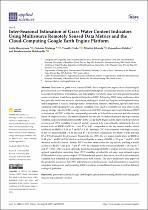| dc.description.abstract | Indicators of grass water content (GWC) have a significant impact on eco-hydrological
processes such as evapotranspiration and rainfall interception. Several site-specific factors such as
seasonal precipitation, temperature, and topographic variations cause soil and ground moisture
content variations, which have significant impacts on GWC. Estimating GWC using multisource data
may provide robust and accurate predictions, making it a useful tool for plant water quantification
and management at various landscape scales. In this study, Sentinel-2 MSI bands, spectral derivatives
combined with topographic and climatic variables, were used to estimate leaf area index (LAI),
canopy storage capacity (CSC), canopy water content (CWC) and equivalent water thickness (EWT)
as indicators of GWC within the communal grasslands in Vulindlela across wet and dry seasons
based on single-year data. The results illustrate that the use of combined spectral and topo-climatic
variables, coupled with random forest (RF) in the Google Earth Engine (GEE), improved the prediction
accuracies of GWC variables across wet and dry seasons. LAI was optimally estimated in the wet
season with an RMSE of 0.03 m2 and R2 of 0.83, comparable to the dry season results, which
exhibited an RMSE of 0.04 m2 and R2 of 0.90. Similarly, CSC was estimated with high accuracy
in the wet season (RMSE = 0.01 mm and R2 = 0.86) when compared to the RMSE of 0.03 mm and
R2 of 0.93 obtained in the dry season. Meanwhile, for CWC, the wet season results show an RMSE of
19.42 g/m2 and R2 of 0.76, which were lower than the accuracy of RMSE = 1.35 g/m2 and R2 = 0.87
obtained in the dry season. Finally, EWT was best estimated in the dry season, yielding a model
accuracy of RMSE = 2.01 g/m2 and R2 = 0.91 as compared to the wet season (RMSE = 10.75 g/m2
and R2 = 0.65). CSC was best optimally predicted amongst all GWC variables in both seasons. The
optimal variables for estimating these GWC variables included the red-edge, near-infrared region
(NIR) and short-wave infrared region (SWIR) bands and spectral derivatives, as well as environmental
variables such as rainfall and temperature across both seasons. The use of multisource data improved
the prediction accuracies for GWC indicators across both seasons. Such information is crucial for
rangeland managers in understanding GWC variations across different seasons as well as different
ecological gradients. | en_US |

